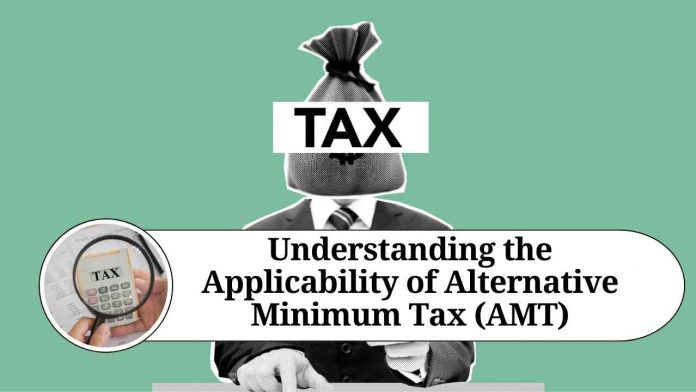Taxation is an essential aspect of any economy, and governments use it to generate revenue for public services and infrastructure development. The Alternative Minimum Tax (AMT) is a tax provision implemented in several countries, including the United States, to ensure that high-income individuals and corporations pay a minimum level of tax regardless of deductions and exemptions. In this blog post, we will explore the concept of AMT, its applicability, and its implications for taxpayers.
What is Alternative Minimum Tax (AMT)?
The Alternative Minimum Tax (AMT) is a parallel tax system that operates alongside the regular income tax system. Its purpose is to ensure that taxpayers who may have otherwise qualified for substantial deductions and exemptions pay a minimum amount of tax. The AMT system has different rules and rates compared to the regular tax system.
Applicability of AMT:
The AMT primarily targets high-income individuals and corporations with significant deductions, exemptions, and credits. It is designed to prevent taxpayers from using these tax benefits excessively to reduce their overall tax liability. The AMT system imposes a minimum tax liability on taxpayers if their tax liability under the regular tax system falls below a certain threshold.
In the United States, the applicability of AMT depends on various factors, including the taxpayer’s filing status, income level, and the specific deductions and exemptions they claim. Historically, the AMT has affected a significant number of individuals and corporations, particularly those with higher incomes.
Implications of AMT:
The Alternative Minimum Tax can have several implications for taxpayers. Here are a few key points to consider:
- Complex calculations: Calculating AMT liability can be complex due to the different rules and rates involved. Taxpayers may need to fill out additional forms and make adjustments to their regular tax calculations.
- Reduced deductions and exemptions: The AMT system disallows or limits certain deductions and exemptions that are allowed under the regular tax system. This can lead to a higher tax liability for affected taxpayers.
- Higher effective tax rates: Due to the disallowed deductions and exemptions, the AMT system can result in a higher effective tax rate for taxpayers. It effectively eliminates or reduces the tax benefits they would have otherwise received.
- Regional variations: The applicability and rules of AMT may vary from country to country. Taxpayers must understand the specific provisions and regulations of their respective jurisdictions.
- Planning and compliance: Taxpayers subject to AMT may need to engage in additional tax planning and compliance efforts to minimize their liability. Consulting with tax professionals can be beneficial in navigating the complexities of the AMT system.
Conclusion
The Alternative Minimum Tax (AMT) is a tax provision aimed at ensuring that high-income individuals and corporations pay a minimum level of tax, irrespective of deductions and exemptions. Its applicability varies based on income levels, filing status, and other factors. Taxpayers subject to AMT may face complex calculations, reduced deductions, and exemptions, higher effective tax rates, and the need for additional planning and compliance efforts. Understanding the AMT system and seeking professional advice can help taxpayers navigate its intricacies and fulfill their tax obligations efficiently.
Other Related Blogs: Section 144B Income Tax Act
Frequently Ask Question
Q1: What is the Alternative Minimum Tax (AMT)?
A1: The Alternative Minimum Tax (AMT) is a parallel tax system that operates alongside the regular income tax system. It is designed to ensure that high-income individuals and corporations pay a minimum level of tax, regardless of deductions and exemptions.
Q2: Who is subject to AMT?
A2: AMT primarily affects taxpayers with higher incomes who have significant deductions, exemptions, and credits. The specific applicability of AMT depends on factors such as filing status, income level, and the deductions and exemptions claimed.
Q3: How does AMT differ from the regular tax system?
A3: The regular tax system allows taxpayers to claim various deductions and exemptions to reduce their tax liability. However, AMT disallows or limits certain deductions and exemptions, imposing a minimum tax liability. AMT has its own set of rules and rates, which may result in a higher effective tax rate for affected taxpayers.
Q4: How do I know if I am subject to AMT?
A4: To determine if you are subject to AMT, you should review your tax return and calculate your alternative minimum taxable income (AMTI). If your AMTI exceeds the exemption amount set by the tax authorities, you may be subject to AMT. Consulting with a tax professional can provide more accurate guidance based on your specific circumstances.
Q5: What are some common deductions and exemptions disallowed or limited under AMT?
A5: The deductions and exemptions disallowed or limited under AMT vary depending on the tax jurisdiction. However, some common examples include state and local tax deductions, certain itemized deductions such as home equity loan interest, and personal exemptions.
Q6: How does AMT impact my tax liability?
A6: AMT can impact your tax liability in several ways. It may increase your overall tax liability by disallowing or limiting certain deductions and exemptions. This effectively eliminates or reduces the tax benefits you would have otherwise received under the regular tax system.
Q7: Are there any strategies to minimize AMT liability?
A7: Minimizing AMT liability requires careful tax planning. Strategies may include adjusting the timing of income and deductions, maximizing tax credits, and considering the impact of investments and exemptions on AMT calculations. Consulting with a tax professional can help identify specific strategies based on your situation.
Q8: Do all countries have an AMT system?
A8: No, the applicability and existence of AMT vary from country to country. While the United States has an AMT system, not all countries have a similar provision. It is essential to understand the tax regulations of your specific jurisdiction.
Q9: Is AMT permanent or subject to change?
A9: Tax laws and provisions, including AMT, can change over time. Governments may revise or eliminate AMT based on evolving economic and fiscal policies. It is important to stay updated with tax law changes and consult with tax professionals to understand the current applicability of AMT.
Q10: Can I calculate AMT on my own, or do I need professional assistance?
A10: Calculating AMT can be complex due to the different rules and rates involved. While it is possible to calculate AMT on your own, seeking assistance from a tax professional is recommended, especially if you have a complex financial situation or are uncertain about the calculations. They can provide expertise and guidance tailored to your specific needs.




















